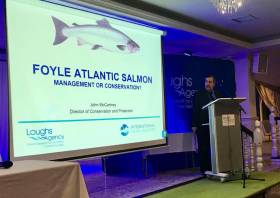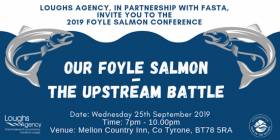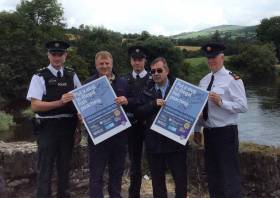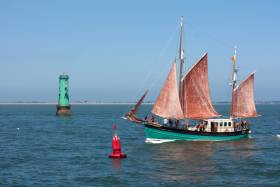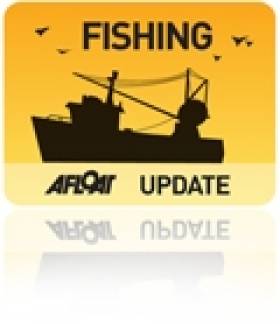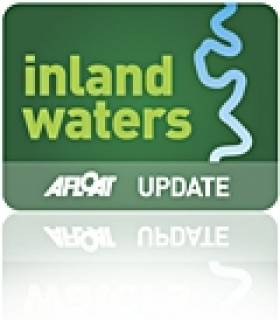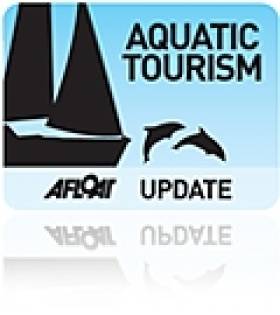Displaying items by tag: Loughs Agency
Collective Work Needed To Arrest Decline Of Salmon In Foyle & Carlingford, Conference Hears
Collective work between scientists and the angling community for the survival of salmon in the cross-border catchments of Foyle and Carlingford was to the fore at the recent conference in Omagh hosted by the Loughs Agency.
Stark warnings over the decline of the species were heard along with presentations from the likes of Dr Diego Del Villar, who discussed the new SeaMonitor project that is currently studying the seas around Ireland, Northern Ireland and western Scotland, and will in time help produce a salmon management plan for the River Foyle.
The Loughs Agency says it will soon launch a public consultation to gauge the views of the public in managing the salmon fishery.
John McCartney, Loughs Agency director of conservation and protection, said: “We value the input and opinion of the public when reviewing our salmon management programme. I would encourage everyone take time to consider and respond to the questions.”
‘Our Foyle Salmon’ Conference In Omagh Next Month
The Loughs Agency is teaming up with the Foyle Association of Salmon and Trout Anglers (FASTA) to host an evening salmon conference in Omagh, Co Tyrone next month.
Our Foyle Salmon – The Upstream Battle at the Mellon Country Inn from 7pm on Wednesday 25 September will hear from speakers on a range of issues including the status of salmon in the River Foyle, current research, threats and steps that can be taken to sustain and protect the species.
This is a fully ticketed event; tickets are free and available through Eventbrite with a maximum of two tickets per transaction.
When registering for tickets you can also submit a question to the panel for the Q&A session at the conference.
‘Operation Silver Fin’ To Tackle Fish Poaching In Co Tyrone
The Loughs Agency has teamed up with police on both sides of the border and a local wildlife group in a joint initiative to tackle fish poaching in Co Tyrone, as Independent.ie reports.
‘Operation Silver Fin’ will take on the scourge of wildlife crime in the area, with a focus on enforcing existing fishing regulations to protect an important angling resource.
Fish poaching, which uses long lines and nets, is only permitted in certain areas — while anyone angling requires a licence and must follow strict rules around where, when and how they fish.
Independent.ie has more on the story HERE.
#TallShips- An opportunity for local young people of all backgrounds and abilities are being offered the chance of a lifetime to take part in a sea voyage between Derry-Londonderry and Belfast as part of the Foyle Maritime Festival 2018.
The inaugural voyages will see 10 young people from the North West take part in the Foyle Sail Training Programme in July 2018 alongside 10 young people from Belfast under the guidance of Sail Training Ireland, which has been organising and co-ordinating sail training voyages since its foundation in 2011.
Voyage One, which is open to 15 – 17 year olds, will arrive in Derry on Saturday, July 21st and Voyage Two, with a crew of 18 – 30 year olds, will depart the following day, Sunday, July 22nd, to make the return journey to Belfast. Each voyage aboard the vessel ‘Brian Boru’ lasts for six days and will equip participants with life changing skills.
The project is supported by Derry City and Strabane District Council and the Loughs Agency.
Eileen McGrinder, Project Officer with Derry City and Strabane District Council, said: “This is a brilliant opportunity for any young person who is thinking of applying, this voyage is an ideal way to step outside your comfort zone, learn new skills, build confidence and make new friends alongside having a great time on the voyage”.
Kevin Wilson, Director of Development, Loughs Agency, said: “The voyage will bring sailing to life for the 20 lucky participants. It will be a challenge, but the experience will create friendships and unforgettable memories. Sailing in the Foyle is accessible for all ages and abilities through local clubs and activity providers on both sides of the border. This is a wonderful opportunity to take the plunge and try something new.”
Sail Training Ireland (STIRL) is incorporated as a not-for-profit limited company in Ireland and has charitable status (CHY20067). It is recognised by Sail Training International as the representative body for Sail Training activities in Ireland.
Foyle Maritime Festival runs from Saturday, July 14th until Sunday, July 22nd when the Clipper 2017-18 Race yachts will be moored at the marina. There will be an array of water-based activities on offer as well as food and craft markets and showcase events. For a full programme, go to: www.foylemaritime.com
The deadline for applications to Foyle Sail Training Programme is Friday, June 15th, 2018.
Applications can be made by individuals or by youth groups, community projects, scouts, and clubs that work with young people to nominate deserving candidates for funded berths.
To apply online, visit: www.sailtrainingireland.com or contact Sail Training Ireland on 00 353 1 816 8866 or at [email protected]
Tyrone Fish Farm Escapees Number In Hundreds Of Thousands
#Angling - Hundreds of thousands of rainbow trout escaped from a commercial fish farm in Co Tyrone last year, according to the Loughs Agency.
BBC News has details on the cross-border body’s report into the incident on the River Strule at Newtownstewart in August 2017, which estimates some 387,000 female rainbow trout entered the river system.
Despite concerns over potential widespread impact on the wild salmon and trout fishery in the area, it’s believed the majority are still concentrated in the lower Strule, lower Derg and upper Mourne.
Local anglers are asked to continue taking the farmed fish from these rivers and reporting their catches, particularly from important spawning grounds, as mass removal is not an option.
Oyster Beds to Reopen On The Foyle
#oysters – Minister of State at the Department of Communications, Energy and Natural Resources, Joe McHugh T.D. and the North's Agriculture Minister Michelle O'Neill MLA, jointly welcomed the decision by the Loughs Agency to re-open two of the six main oyster fishing beds in Lough Foyle which had been closed for the last number of weeks.
Minister McHugh said: "The decision to partially re-open the beds from 15 to 19 December 2014 will create potential opportunity to catch up to an additional 25 tonnes (up to a value of €125,000). I believe that the Agency has achieved a good balance between economic opportunity for local fishermen with a dividend for the local communities and the conservation imperative".
He added "I want to emphasise that sustainability and safeguarding this natural resource in Lough Foyle are the shared responsibilities of all stakeholders, including the licensed fishermen."
Minister O'Neill said: "Whilst I appreciate the importance of Management interventions to conserve and maintain oyster stocks, I am mindful of the impact that closure of the oyster beds has had on the livelihood of local oystermen particularly in the run-up to Christmas.
"Looking to the future, I am hopeful that there will be constructive engagement between the Agency and local fishermen on a range of issues that will safeguard the future of the Native Oyster Fishery on Lough Foyle.
Ministers had jointly raised the issue of the closure of the oyster beds at the North South Ministerial Council Aquaculture and Marine Sectoral Meeting in Armagh last Friday when they asked the Agency to review its decision to close the main oyster beds.
The Ministers pointed out the need to strike a balance between the socio-economic benefits for the Foyle Oyster Fishermen and the scientific evidence to support the long term sustainability of the Native Oyster Fishery on Lough Foyle.
Both Ministers thanked the Chairman, Chief Executive and the Loughs Agency staff for efforts in reaching this decision.
#InlandWaterways - Minister Fergus O'Dowd today (3 May) helped launch a new pilot scheme by Inland Fisheries Ireland (IFI) through which angling clubs and organisations can access funding to undertake sustainable development works in the Midland Fisheries Group permit area.
The Midland Fisheries Fund has an initial allocation of €50,000 which has been created from angler contributions set aside from the permit income received by IFI in the Midlands Fisheries Group area. The scheme, which is similar in design to the Salmon Conservation Fund, will allow for habitat improvement but importantly also includes angling development projects in Midlands waterways.
Successful applications will be provided with technical assistance to help them become reality and will foster links between the fishery owners, State agencies and land owners.
The application process itself, says IFI, "will instill confidence in project promoters who are often apprehensive due to the complicated nature of forms and permissions".
The scheme is exclusive to the Midland Fisheries Group area and is only open to clubs in that area.
Minister O'Dowd said at the launch: "This fund reaffirms IFI’s objective to facilitate stakeholders to undertake sustainable development works. These works will enhance and improve fisheries habitats and angling tourism potential and the contribution the inland fisheries resource makes to the economy."
The minister - who is currently undertaking a public consultation around the country in relation to the review of fisheries legislation - said he was encouraged by the angling stakeholders' enthusiasm, knowledge and interest in protecting, managing and developing the resource.
"This scheme encapsulates the partnership approach between IFI and its stakeholders, ensuring projects are environmentally sustainable, undertaken with the appropriate permissions and guidance and developed by local angling clubs for the benefit of locals and tourists alike," he said.
An information evening on the Midland Fisheries Fund will take place in Lough Owel Angling Centre on 14 May at 6.30pm.
Application forms for the fund are available online HERE. The closing date for receipt of application forms is 15 June 2013.
Meanwhile, the North South Ministerial Council (NSMC) has backed an initiative for the Loughs Agency to support the Carlingford Oyster Festival this August.
The Aquaculture and Marine sectoral meeting held in Carlingford this morning was attended by Minister for Natural Resources Pat Rabbitte, NI Minister for Rural Development Michelle O’Neill, Minister Fergus O’Dowd and NI Minister Nelson McCausland, who were all keen to endorse the proposals of the Loughs Agency to support the festival.
Taking place from 8-11 August, the festival has been developed by the Carlingford Cooley Tourism Association as a family-oriented event that showcases locally produced oysters and seafood. The agency will work in partnership with the local festival organisers on the annual event which attracts large numbers of visitors to the Carlingford area.
Minister O'Dowd said the festival “offers a real opportunity to showcase local produce and bring an international focus on Carlingford Lough as a production area of distinction for excellence seafood."
The ministers were also keen to emphasise that the tourism and visitor potential of the lough area should also benefit from a strong and vibrant oyster festival featuring as an attractive occasion on tourism and event calendars across the island and internationally.
#MARINE TOURISM - The Loughs Agency has announced the availability of funding of up to £7,500 (€9,200) to support angling development and/or marine tourism projects that benefit the Foyle or Carlingford areas.
The limited budget comes by way of the cross-border agency's Sustainable Development Fund, and it advises that only a small number of projects may receive funding.
Applications will be accepted under the themes of developing access and other infrastructure for marine tourism and angling; developing marine tourism and angling products; providing accommodation and facilities for anglers and tourists; and training to develop and enhance capacity for angling and tourism.
Funding will be at a level of up to 75% of total eligible expenditure, and all public sector requirements apply for procurement (including quotes). Approved projects must also be completed by December this year.
Completed application forms must be received at Loughs Agency headquarters by 9.30am on Tuesday 17 July 2012.
Inland Fisheries Ireland has full details HERE on the project criteria and how to apply for funding. Application forms are available on the Loughs Agency website HERE.
New Coastal Canoe Trails for Northern Ireland
This week Northern Ireland welcomes the launch of two new coastal canoe trails.
The new Foyle Canoe Trail stretches for 33 miles from Lifford in Co Donegal to Moville on the Inishowen peninsula at Lough Foyle, passing through Derry on the way, with plenty of wild and official campsites along the route.
Meanwhile, the South East Coast Canoe Trail is a sea kayaker's dream – 50 miles of rocky bays and sandy beaches past the Mourne and Cooley mountain ranges from Strangford village to Newry.
According to OutdoorNI.com, the trails were developed by the Countryside Access and Activities Network (CAAN), the Loughs Agency and Down and Derry District Councils, add to the five inland canoe trails already in place.
CAAN development officer Kathryn Callaghan commented: "Both these trails offer a golden opportunity for us all to explore two picturesque corners of Northern Ireland from a unique perspective.”
Waterproof guides for both trails are available free from from local tourist information centres or online from www.canoeni.com.
The coastal trails are the first of four to be launched in 2011. Later this year the North Coast Canoe Trail will take in the Giant’s Causeway and Carrick-a-rede Rope Bridge, while the East Coast Canoe Trail will pass the renowned Glens of Antrim, Belfast Lough and the Ards peninsula.


























